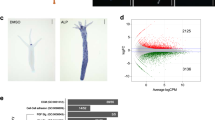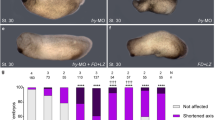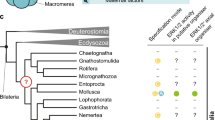Abstract
The Spemann organizer in amphibian embryos is a tissue with potent head-inducing activity, the molecular nature of which is unresolved. Here we describe dickkopf-1 (dkk-1), which encodes Dkk-1, a secreted inducer of Spemann's organizer in Xenopus and a member of a new protein family. Injections of mRNA and antibody indicate that dkk-1 is sufficient and necessary to cause head induction. dkk-1 is a potent antagonist of Wnt signalling, suggesting that dkk genes encode a family of secreted Wnt inhibitors.
This is a preview of subscription content, access via your institution
Access options
Subscribe to this journal
Receive 51 print issues and online access
$199.00 per year
only $3.90 per issue
Buy this article
- Purchase on Springer Link
- Instant access to full article PDF
Prices may be subject to local taxes which are calculated during checkout






Similar content being viewed by others
References
Sasai, Y. & De Robertis, E. M. Ectodermal patterning in vertebrate embryos. Dev. Biol. 182, 5–20 (1997).
Gerhart, J., Doniach, T. & Steward, R. in Gastrulation (eds Keller, R., Clark, W. H. & Griffin, F.) 57–77 (Plenum, New York, 1991).
Lemaire, P. & Kodjabachian, L. The vertebrate organizer, structure and molecules. Trends Genet. 12, 525–531 (1996).
Bouwmeester, T., Kim, S.-H., Sasai, Y., Li, B. & De Robertis, E. M. Cerberus is a head-inducing secreted factor expressed in the anterior endoderm of Spemann's organizer. Nature 382, 595–601 (1996).
Bally-cuif, L. & Boncinelli, E. Transcription factors and head formation in vertebrates. BioEssays 19, 127–135 (1997).
Glinka, A., Wu, W., Onichtchouk, D., Blumenstock, C. & Niehrs, C. Head induction by simultaneous repression of Bmp and Wnt signalling in Xenopus. Nature 389, 517–519 (1977).
Nusse, R. & Varmus, H. E. Wnt genes. Cell 69, 1073–1087 (1992).
Parr, B. A. & McMahon, A. P. Wnt-genes and vertebrate development. Curr. Opin. Genet. Dev. 4, 523–528 (1994).
Moon, R. T., Brown, J. D. & Torres, M. Wnts modulate cell fate and behavior during vertebrate development. Trends Genet. 13, 157–162 (1997).
Wang, S., Krinks, M., Lin, K., Luyten, F. P. & Moos, M. Frzb, a secreted protein expressed in the Spemann organizer, binds and inhibits Wnt-8. Cell 88, 757–766 (1997).
Leyns, L., Bouwmeester, T., Kim, S.-H., Piccolo, S. & De Robertis, E. M. Frzb-1 is a secreted antagonist of wnt-signals expressed in the Spemann organizer. Cell 88, 747–756 (1997).
Glinka, A., Delius, H., Blumenstock, C. & Niehrs, C. Combinatorial signalling by Xwnt-11 and Xnr3 in the organizer epithelium. Mech. Dev. 60, 221–231 (1996).
Suzuki, A.et al. Atruncated bone morphogenetic protein receptor affects dorsal-ventral patterning in the early Xenopus embryo. Proc. Natl Acad. Sci. USA 91, 10255–10259 (1994).
Sasai, Y.et al. Xenopus chordin: a novel dorsalizing factor activated by organizer-specific homeobox genes. Cell 79, 779–790 (1994).
Devoto, S. H., Melancon, E., Eisen, J. S. & Westerfield, M. Identification of separate slow and fast muscle pioneer cells in vivo, prior to somite formation. Development 122, 3371–3380 (1996).
Kao, K. R. & Elinson, R. P. The entire mesodermal mantle behaves as Spemann's organizer in dorsoanterior enhanced Xenopus laevis embryos. Dev. Biol. 127, 64–77 (1988).
Cho, K. W., Blumberg, B., Steinbeisser, H. & De Robertis, E. M. Molecular nature of Spemann's organizer: the role of the Xenopus homeobox gene goosecoid. Cell 67, 1111–1120 (1991).
Blitz, I. L. & Cho, K. W. Y. Anterior neuroectoderm is progressively induced during gastrulation: the role of the Xenopus homeobox gene orthodenticle. Development 121, 993–1004 (1995).
Pannese, M.et al. The Xenopus homologue of Otx2 is a maternal homeobox gene that demarcates and specifies anterior body regions. Development 121, 707–720 (1995).
Gammil, L. S. & Sive, H. Identification of otx2 target genes and restrictions in ectodermal competence during cement gland formation. Development 124, 471–481 (1996).
Sasai, Y., Lu, B., Steinbeisser, H. & De Robertis, E. M. Regulation of neural induction by the Chd and Bmp-4 antagonistic patterning signals in Xenopus. Nature 376, 333–336 (1995).
Fagotto, F., Guger, K. & Gumbiner, B. M. Induction of the primary dorsalizing center in Xenopus by the Wnt/GSK/beta-catenin signaling pathway, but not by Vg1, Activin or noggin. Development 124, 453–460 (1996).
Carnac, G., Kodjachbachian, L., Gurdon, J. B. & Lemaire, P. The homeobox gene siamois is a target of the wnt dorsalization pathway and triggers organiser activity in the absence of mesoderm. Development 122, 3055–3065 (1996).
Itoh, K., Tang, T. L., Neel, B. G. & Sokol, S. Y. Specific modulation of ectodermal cell fates in Xenopus embryos by glycogen synthase kinase. Development 121, 3979–3988 (1995).
Smith, J. C., Price, B. M., Green, J. B., Weigel, D. & Herrmann, B. G. Expression of a Xenopus homolog of Brachyury (T) is an immediate-early response to mesoderm induction. Cell 67, 79–87 (1991).
Banville, D. & Williams, J. G. The pattern of expression of the Xenopus laevis tadpole alpha-globin genes and the amino acid sequence of the three major tadpole alpha-globin polypeptides. Nucleic Acids Res 13, 5407–5421 (1985).
Zeng, L.et al. The mouse fused locus encodes axin, an inhibitor of the Wnt-signaling pathway that regulates embryonic axis formation. Cell 90, 181–192 (1997).
Sokol, S. Y., Klingensmith, J., Perrimon, N. & Itoh, K. Dorsalizing and neuralizing properties of Xdsh, a maternally expressed Xenopus homolog of dishevelled. Development 121, 1637–1647 (1995).
Pierce, S. B. & Kimelman, D. Regulation of Spemann organizer formation by the intracellular kinase Xgsk-3. Development 121, 755–765 (1995).
He, X., Saint, J. J., Woodgett, J. R., Varmus, H. E. & Dawid, I. B. Glycogen synthase kinase-3 and dorsoventral patterning in Xenopus embryos. Nature 374, 617–622 (1995).
Karnovsky, A. & Klymkowsky, M. W. Anterior axis duplication in Xenopus induced by the over-expression of the cadherin-binding protein plakoglobin. Proc. Natl Acad. Sci. USA 92, 4522–4526 (1995).
Smith, W. C. & Harland, R. M. Injected Xwnt-8 RNA acts early in Xenopus embryos to promote formation of a vegetal dorsalizing center. Cell 67, 753–765 (1991).
Christian, J. L. & Moon, R. T. Interactions between Xwnt-8 and Spemann organizer signaling pathways generate dorsoventral pattern in the embryonic mesoderm of Xenopus. Genes Dev. 7, 13–28 (1993).
Cui, Y., Brown, J. D., Moon, R. T. & Christian, J. L. Xwnt-8b: a maternally expressed Xenopus Wnt gene with a potential role in establishing the dorsoventral axis. Development 121, 2177–2186 (1995).
Bhanot, P.et al. Anew member of the frizzled family from Drosophila functions as a Wingless receptor. Nature 382, 225–230 (1996).
Lecuit, T. & Cohen, S. M. Proximal–distal axis formation in the Drosophila leg. Nature 388, 139–145 (1997).
Gans, C. & Northcutt, R. G. Neural crest and the origin of vertebrates: a new head. Science 220, 268–274 (1983).
Gawantka, V., Delius, H., Hirschfeld, K., Blumenstock, C. & Niehrs, C. Antagonizing the Spemann organizer: role of the homeobox gene Xvent-1. EMBO J. 14, 6268–6279 (1995).
Monaghan, P. A., Grau, E., Bock, D. & Schütz, G. The mouse homolog of the orphan nuclear receptor tailless is expressed in the developing forebrain. Development 121, 839–853 (1995).
Rupp, R. A., Snider, L. & Weintraub, H. Xenopus embryos regulate the nuclear localization of XMyoD. Genes Dev. 8, 1311–1323 (1994).
Ryan, K., Garrett, N., Mitchell, A. & Gurdon, J. B. Eomesodermin, a key early gene in Xenopus mesoderm differentiation. Cell 87, 989–1000 (1996).
Hardy, S., Fiszman, M. Y., Osborne, H. B. & Thiebaud, P. Characterization of muscle and non muscle Xenopus laevis tropomyosin mRNAs transcribed from the same gene. Developmental and tissue-specific expression. Eur. J. Biochem. 202, 431–440 (1991).
Good, P. J., Richter, K. & Dawid, I. B. The sequence of a nervous system-specific, class II beta-tubulin gene from Xenopus laevis. Nucleic Acids Res. 17, 8000 (1989).
Meier, V. S., Boehni, R. & Schuemperli, D. Nucleotide sequence of two mouse histone H4 genes. Nucleic Acids Res. 17, 795 (1989).
Hemmati-Brivanlou, A. & Melton, D. A. Inhibition of activin receptor signaling promotes neuralization in Xenopus. Cell 77, 273–281 (1994).
Harlow, E. & Lane, D. Antibodies. A Laboratory Manual (Cold Spring Harbor Laboratory Press, NY, 1988).
Acknowledgements
We thank D. Bock, R. Dosch, V. Gawantka, R. Nitsch and N. Pollet for in situ hybridizations; P. Kioschis and N. Pollet for help with DNA sequence analysis; I. Schuster for histology; U.Hebling for assistance with sequencing work; S. Cohen for critically reading the manuscript; and B.Ferreiro, H. Herrmann, D. Kimelman, P. Lemaire, R. Moon, C. Otto, S. Sokol and M. Ueno for providing materials. This work was supported in part by the Deutsche Forschungsgemeinschaft.
Author information
Authors and Affiliations
Rights and permissions
About this article
Cite this article
Glinka, A., Wu, W., Delius, H. et al. Dickkopf-1 is a member of a new family of secreted proteins and functions in head induction. Nature 391, 357–362 (1998). https://doi.org/10.1038/34848
Received:
Accepted:
Issue Date:
DOI: https://doi.org/10.1038/34848
This article is cited by
-
Loss of noggin1, a classic embryonic inducer gene, in elasmobranchs
Scientific Reports (2024)
-
The multi-CDK inhibitor dinaciclib reverses bromo- and extra-terminal domain (BET) inhibitor resistance in acute myeloid leukemia via inhibition of Wnt/β-catenin signaling
Experimental Hematology & Oncology (2024)
-
Update on HCC Surveillance in Patient With Hepatitis B Virus Infection With Focus on Biomarkers
Current Hepatology Reports (2024)
-
New insights in ubiquitin-dependent Wnt receptor regulation in tumorigenesis
In Vitro Cellular & Developmental Biology - Animal (2024)
-
Inhibition of Dickkopf-1 enhances the anti-tumor efficacy of sorafenib via inhibition of the PI3K/Akt and Wnt/β-catenin pathways in hepatocellular carcinoma
Cell Communication and Signaling (2023)
Comments
By submitting a comment you agree to abide by our Terms and Community Guidelines. If you find something abusive or that does not comply with our terms or guidelines please flag it as inappropriate.



